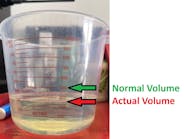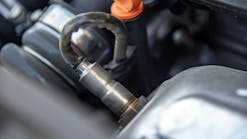Hunt for the Dead Hole
It was not all that long ago that a slight random misfire might go undetected. Misfires generate unburned hydrocarbons and increase the load on the catalytic converter. If the misfire rate is excessive, the catalytic converter can overheat and be damaged. Now, we have OBD II with its misfire detection monitor. The Powertrain Control Module (PCM) monitors the engine operation for misfires and counts the number of misfires that occur in a specified number of engine revolutions.
An engine misfire is a condition that results from either a lack of combustion (total misfire) or an instability that occurs during the combustion process (partial misfire). Unless the fuel mixture is correct, secondary voltage is sufficient and the engine is in good mechanical condition, combustion cannot be initiated. If the combustion process does begin but there is a deficiency in one or more of these areas, the combustion process will end prematurely.OBD II has three different levels of severity concerning engine misfires. Depending on the severity, the misfire will be designated as type A, B or C. Each of these misfire types is determined by a percentage of misfires that occur within a specified timeframe and result in specific failure conditions. The type "A" misfire is the most serious condition and indicates impending catalyst damage. If detected, the Malfunction Indicator Lamp (MIL) may flash once per second to alert the driver that immediate service is required. In addition, a Diagnostic Trouble Code (DTC) is set and freeze frame data is stored. This is a one-trip code.
To identify a type "A" misfire, the diagnostic system counts the percentage of misfires within 200 crankshaft revolutions. If the percentage of misfires decreases to a point where catalyst damage is no longer imminent, the MIL will stop flashing and remain on steady.Types B and C misfires are determined using a 1,000-revolution window and a two-trip monitor. For a misfire to be identified as type B, it must be serious enough to raise emissions more than 1.5 times the Federal Test Procedure (FTP) standards.
A type C misfire is the least severe of the three and indicates that emission levels are high enough for the vehicle to fail an emission test. In either a type B or type C misfire, the MIL will come on steady and a code will set as long as the condition occurs on two consecutive trips.Misfire Monitors
There are two different misfire monitoring technologies used: Low Data Rate (LDR) and High Data Rate (HDR). The LDR system is capable of meeting the FTP monitoring requirements on most engines, and is capable of meeting "full-range" misfire monitoring requirements on 4-cylinder engines. The HDR system is capable of meeting "full-range" misfire monitoring requirements on 6- and 8-cylinder engines. HDR was phased in on these engines to meet the "full-range" misfire requirements specified in the OBD-II regulations. Starting in the 2002 model year, software has been modified to allow for detection of any misfires that occur within six engine revolutions after initially cranking the engine. This meets the OBD-II requirement to identify misfires within two engine revolutions after exceeding the warm drive, idle rpm.
LDR: The LDR Misfire Monitor uses a low-data-rate crankshaft position signal. The PCM calculates crankshaft rotational velocity for each cylinder from this crankshaft position signal. The acceleration for each cylinder can then be calculated using successive velocity values. The changes in overall engine rpm are removed by subtracting the median engine acceleration over a complete engine cycle. The resulting deviant cylinder acceleration values are used in evaluating misfire."Profile correction" software is used to "learn" and correct for mechanical inaccuracies in crankshaft tooth spacing under de-fueled engine conditions (deceleration). These learned corrections improve the high-rpm capability of the monitor for most engines. The misfire monitor is not active until a profile has been learned.
HDR: The HDR Misfire Monitor uses a high-data-rate crankshaft position signal. The high-resolution signal is processed using two different algorithms. The first algorithm is optimized to detect low rates of misfire. The algorithm learns the normal pattern of cylinder accelerations from the mostly good firing events and is then able to accurately detect deviations from that pattern. The second algorithm is designed to detect hard misfires, such as one or more continuously misfiring cylinders. This algorithm filters the high-resolution crankshaft velocity signal to remove some of the crankshaft torsional vibrations that may degrade signal. This significantly improves detection capability for continuous misfires. Both algorithms will produce a deviant cylinder acceleration value, which is used in evaluating misfire.Random Misfire: If the Misfire Monitor detects a random misfire, code P0300 is stored. This can typically be the most difficult code to diagnose, as this condition can result from a number of causes. Random misfires that jump around from one cylinder to another could be the result of a lean fuel condition or a weak spark. The challenge here is determining what is upsetting the fuel mixture or affecting the spark.
Cylinder-specific Misfire: As described earlier, a misfire code can set for a specific cylinder. But keep in mind that code P0302 only tells us that the misfire was detected on cylinder No. 2, but not if the spark plug, wire or ignition coil is causing the misfire. A mechanical failure such as low cylinder compression, or an inactive port fuel injector can also set a misfire code.A word of caution: On some vehicles, it's possible to set false random or individual misfire codes when doing a cranking compression test. If this happens, just clear the codes after the test so the MIL doesn't come on later.
Scan Tool Testing
OBD II misfire codes can point you to which cylinder is misfiring. A code P0306, for example, would indicate that cylinder No. 6 has misfired. But OBD II doesn't tell you why it is misfiring unless there are additional codes, which may help to isolate the problem area. The scan tool will provide misfire codes, freeze frame data, current misfire and other input data. Some systems will also provide misfire history. Many systems allow the ignition coils to be activated from the scan tool, and Mode $06 can be accessed to verify repairs.
- Check and record any stored DTCs.
- Check and record freeze frame data.
- Check and record the data parameters associated with the system involved.
- Check and record current misfire data.
- Perform bi-directional testing on components (when available).
Freeze Frame Data
When diagnosing misfire faults, freeze frame data will provide valuable information concerning the conditions present when the code was stored. This allows us to duplicate these conditions to verify and diagnose the malfunction. When presented with a vehicle having additional DTCs besides misfire, the freeze frame will be related to the misfire due to the misfire DTC having the higher priority. Don't ignore the other codes, however, because the misfire may be related to another DTC.
If a random misfire code is also accompanied by a P0171 code (cylinder bank 1) or P0174 (cylinder bank 2), it will help isolate a lean fuel condition to one side of the engine or the other. If you find any codes in the P0400 to P0408 range, it may indicate an EGR-related problem.
You should always look at the freeze frame data first when diagnosing a misfire code. If the code was set when the engine was cold, chances are we have an intake manifold leak that seals itself as the engine warms or the OBD II system is being overly sensitive and there is no real misfire problem. Check for any technical service bulletins (TSBs) on that vehicle for false misfire codes. The cure, in many instances, may be to reprogram the PCM so the OBD-II system will be less sensitive to certain misfires.
Keep in mind that replacing spark plugs with plugs from a different manufacturer or plugs of the wrong heat range or design for that specific application often causes misfire codes. In cases where there's a cylinder misfire code and no other codes present, the ignition or fuel delivery system may be borderline, but not bad enough to set a code of its own. A shorted or open fuel injector solenoid, or a shorted or open coil, will usually set a code, but a dirty or weak fuel injector or a weak coil may not set a code.
If you're dealing with a random misfire that can't be isolated to a particular cylinder, look at current fuel trim data while duplicating rpm and load that was recorded from the freeze frame. A lean condition could be the result of dirty injectors, fuel pressure, vacuum leaks, EGR or even an out-of-range Mass Air Flow (MAF) sensor. Be aware that there have been cases of a MAF causing random or specific cylinder misfire codes when cold without setting a MAF or fuel control code.
Based on the results of the Preliminary Checks and Scan Tool Testing, we can move into a diagnostic process based on the individual components involved.
Injector Shutdown
Many manufacturers are shutting down the injector of a cylinder that develops a misfire. This is done to prevent premature damage to the catalytic converter. The cylinder-specific misfire monitors will be used to shut off fuel to the affected cylinders. This means all OBD II systems with this function (typically V8 and V6 engines) will have to be sequentially fuel-injected (as opposed to gang-fired injection). The fuel injector will remain inoperative until the misfire code for that cylinder is erased. Testing for an injector pulse on a misfiring cylinder and finding none, and thereby assuming the injector driver is bad on one of these systems, would be a costly mistake.
Using Mode $06 Test Data
Mode $06 is the test data that OBD II looks at when it decides to set a pending code or a current fault code. If the test data is within vehicle manufacturer established limits, the test passes and no codes are set. If a value is out of range, OBD II flags it with a failure and keeps an eye on the component until the system monitor has run at least twice. Then, if the problem is still there, a DTC is set and the MIL illuminates.
The early scan tools typically display Mode $06 data in hex code, while some of the newer scan tools translate the data and display it by component and test value. This information can be invaluable in verifying repairs. Mode $06 has to be accessed in order to read current misfire data on most Ford vehicles.
All the basic misfire diagnosis we learned prior to OBD II still applies. The difference now is that many misfires will be detected by the PCM that otherwise may have gone unnoticed before OBD II. Now we have more data available to help us isolate the problem, but the most important diagnostic tool is still your own knowledge of how the system works.
Roy Ripple serves as the Motor Age Troubleshooting editor. An ASE Master Technician with L1 certification and now semi-retired, Roy was previously a hotline technical support specialist for Delphi Product and Service Solutions, an advisor with the Chilton Book Co., and a shop owner.


